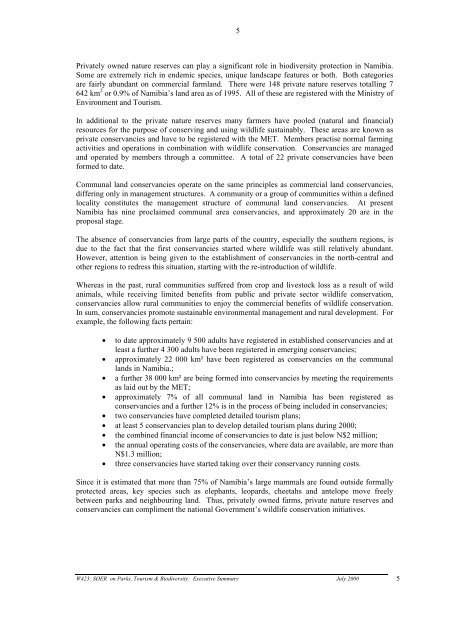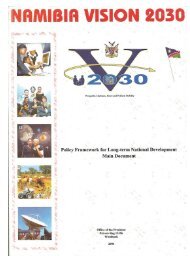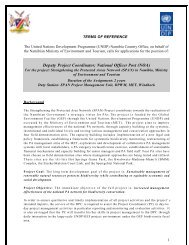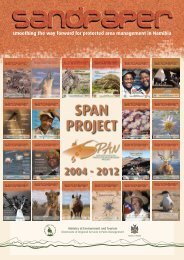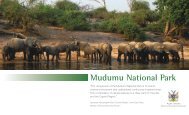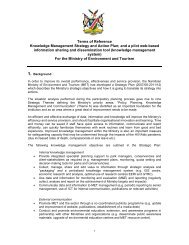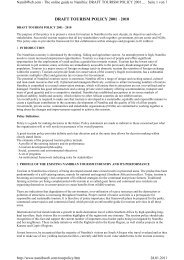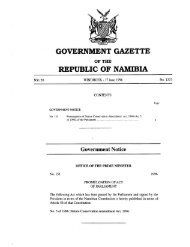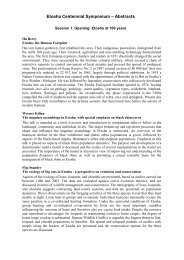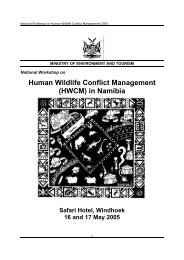EXECUTIVE SUMMARY - Ministry of Environment and Tourism
EXECUTIVE SUMMARY - Ministry of Environment and Tourism
EXECUTIVE SUMMARY - Ministry of Environment and Tourism
Create successful ePaper yourself
Turn your PDF publications into a flip-book with our unique Google optimized e-Paper software.
5<br />
Privately owned nature reserves can play a significant role in biodiversity protection in Namibia.<br />
Some are extremely rich in endemic species, unique l<strong>and</strong>scape features or both. Both categories<br />
are fairly abundant on commercial farml<strong>and</strong>. There were 148 private nature reserves totalling 7<br />
642 km 2 or 0.9% <strong>of</strong> Namibia’s l<strong>and</strong> area as <strong>of</strong> 1995. All <strong>of</strong> these are registered with the <strong>Ministry</strong> <strong>of</strong><br />
<strong>Environment</strong> <strong>and</strong> <strong>Tourism</strong>.<br />
In additional to the private nature reserves many farmers have pooled (natural <strong>and</strong> financial)<br />
resources for the purpose <strong>of</strong> conserving <strong>and</strong> using wildlife sustainably. These areas are known as<br />
private conservancies <strong>and</strong> have to be registered with the MET. Members practise normal farming<br />
activities <strong>and</strong> operations in combination with wildlife conservation. Conservancies are managed<br />
<strong>and</strong> operated by members through a committee. A total <strong>of</strong> 22 private conservancies have been<br />
formed to date.<br />
Communal l<strong>and</strong> conservancies operate on the same principles as commercial l<strong>and</strong> conservancies,<br />
differing only in management structures. A community or a group <strong>of</strong> communities within a defined<br />
locality constitutes the management structure <strong>of</strong> communal l<strong>and</strong> conservancies. At present<br />
Namibia has nine proclaimed communal area conservancies, <strong>and</strong> approximately 20 are in the<br />
proposal stage.<br />
The absence <strong>of</strong> conservancies from large parts <strong>of</strong> the country, especially the southern regions, is<br />
due to the fact that the first conservancies started where wildlife was still relatively abundant.<br />
However, attention is being given to the establishment <strong>of</strong> conservancies in the north-central <strong>and</strong><br />
other regions to redress this situation, starting with the re-introduction <strong>of</strong> wildlife.<br />
Whereas in the past, rural communities suffered from crop <strong>and</strong> livestock loss as a result <strong>of</strong> wild<br />
animals, while receiving limited benefits from public <strong>and</strong> private sector wildlife conservation,<br />
conservancies allow rural communities to enjoy the commercial benefits <strong>of</strong> wildlife conservation.<br />
In sum, conservancies promote sustainable environmental management <strong>and</strong> rural development. For<br />
example, the following facts pertain:<br />
• to date approximately 9 500 adults have registered in established conservancies <strong>and</strong> at<br />
least a further 4 300 adults have been registered in emerging conservancies;<br />
• approximately 22 000 km² have been registered as conservancies on the communal<br />
l<strong>and</strong>s in Namibia.;<br />
• a further 38 000 km² are being formed into conservancies by meeting the requirements<br />
as laid out by the MET;<br />
• approximately 7% <strong>of</strong> all communal l<strong>and</strong> in Namibia has been registered as<br />
conservancies <strong>and</strong> a further 12% is in the process <strong>of</strong> being included in conservancies;<br />
• two conservancies have completed detailed tourism plans;<br />
• at least 5 conservancies plan to develop detailed tourism plans during 2000;<br />
• the combined financial income <strong>of</strong> conservancies to date is just below N$2 million;<br />
• the annual operating costs <strong>of</strong> the conservancies, where data are available, are more than<br />
N$1.3 million;<br />
• three conservancies have started taking over their conservancy running costs.<br />
Since it is estimated that more than 75% <strong>of</strong> Namibia’s large mammals are found outside formally<br />
protected areas, key species such as elephants, leopards, cheetahs <strong>and</strong> antelope move freely<br />
between parks <strong>and</strong> neighbouring l<strong>and</strong>. Thus, privately owned farms, private nature reserves <strong>and</strong><br />
conservancies can compliment the national Government’s wildlife conservation initiatives.<br />
W423: SOER on Parks, <strong>Tourism</strong> & Biodiversity: Executive Summary July 2000 5


